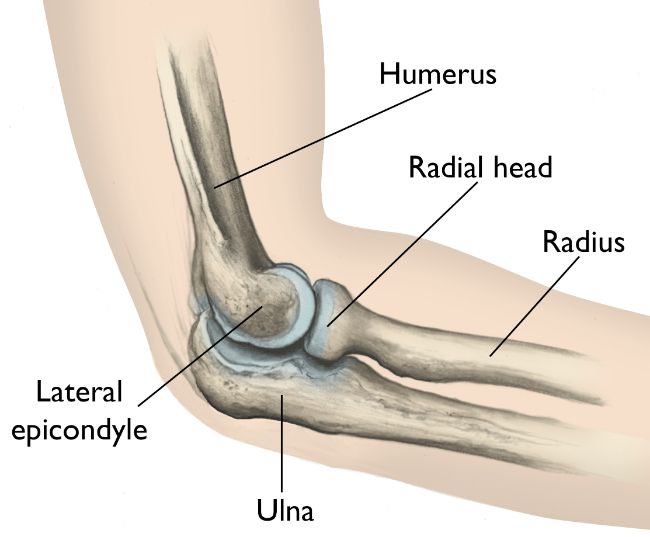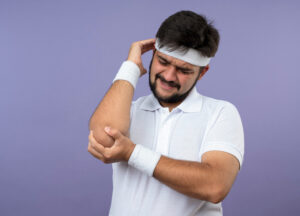Overview
What is Tennis Elbow?
Tennis elbow, also known as lateral epicondylitis, involves inflammation of the tendons responsible for bending your wrist back, away from your palm.
Although labeled as such, the majority of individuals afflicted with tennis elbow are not tennis players. Certain occupations, such as plumbing, painting, carpentry, and butchery, which entail repetitive actions, can predispose individuals to tennis elbow. Nevertheless, in many cases, the exact cause of tennis elbow remains unclear.
The discomfort associated with tennis elbow primarily manifests at the point where the sturdy, cord-like tissues of the forearm muscles connect to a bony protrusion on the outer side of the elbow. These tissues, referred to as tendons, may cause pain that extends into the forearm and wrist.
Ligament injuries
Your elbow is a very stable joint, but it still may be injured if the right stress or trauma occurs. Typical ligament injuries affecting your elbow might comprise:
- Ulnar collateral ligament rupture
- Annular ligament disruption, especially after a radial head fracture
- Radial collateral ligament rupture
- Elbow dislocation

Symptoms & Causes
Symptoms
The primary symptoms of tennis elbow typically involve:
Pain in the elbow, particularly on the outer side, away from the body’s center when the arms are at rest with the palms facing forward.
- Stiffness.
- Inflammation.
- Reduced grip strength, especially noticeable when holding objects such as a racket, pen, or during handshakes.
Causes
Tennis elbow is frequently associated with overuse and strain on the muscles, although its exact cause remains unclear. Sometimes, repetitive contraction of the forearm muscles responsible for extending and lifting the hand and wrist can trigger symptoms. This repetitive stress may lead to damage of the tendon fibers that connect the forearm muscles to the bony prominence on the outer side of the elbow.
Activities that commonly result in tennis elbow symptoms include:
- Participating in racket sports, particularly using a backhand stroke, with improper technique.
- Engaging in plumbing work.
- Painting.
- Screwing or unscrewing.
- Slicing foods for cooking, especially meat.
- Prolonged use of a computer mouse.
Occasionally, an injury or a condition affecting the body’s connective tissues can precipitate tennis elbow. Nevertheless, the precise cause often remains unidentified.
Risks & Complications
Risk Factors
Factors that may elevate the risk of tennis elbow comprise:
While tennis elbow can affect anyone, certain individuals are more predisposed, including those who:
- Regularly lift weights exceeding 45 pounds (22 kilograms).
- Are over the age of 40.
- Smoke.
- Have obesity, defined as a body mass index (BMI) of 30 or higher.
Athletes engaged in sports placing strain on their arms or elbows, such as:
- Tennis (and other racket sports like squash, pickleball, or racquetball).
- Baseball.
- Softball.
- Bowling.
- Golf.
- Weightlifting.
Individuals whose occupations or pastimes involve significant stress on their elbows, such as:
- Painters.
- Musicians.
- Chefs or cooks.
- Carpenters.
- Plumbers.
- Cleaners.
- Gardeners.
- Manicurists.
What are the potential complications of tennis elbow?
Tennis elbow typically does not lead to significant complications. However, continuing to use your injured elbow before the tendon has fully healed can heighten the risk of rupture (tearing).
Diagnosis & Treatment of Tennis Elbow
Diagnosis
Tennis Elbow can be diagnosed by:
- Elbow X-ray.
- Ultrasound.
- Magnetic resonance imaging (MRI).
- Electromyography (EMG).
Treatment
It is crucial to refrain from the movement that initially caused your injury. Treatment options may involve:
- Rest and discontinuing the activity that triggers symptoms
- Using ice packs to reduce inflammation
- Participation in strengthening and stretching exercises
- Administration of anti-inflammatory medications like ibuprofen or naproxen
- Application of a compression bandage around the elbow
If these measures prove ineffective, your orthopedic doctor might consider:
- Immobilizing the area with a brace for several weeks or utilizing a specialized brace during activities
- Administering steroid injections to reduce swelling and pain
- Employing shock wave therapy, a specialized form of ultrasound, to break up scar tissue, enhance blood circulation, and facilitate healing
- Performing platelet-rich plasma (PRP) therapy, which involves injecting your own blood platelets into the affected region to stimulate healing
- Surgery, which is reserved for rare cases when symptoms do not respond to other treatments.
Tennis Elbow Exercises
Physical therapy is a frequently recommended approach for tennis elbow, regardless of whether surgery is required. Below are some exercises that could aid in alleviating your symptoms as suggested by Dr. Preetesh Choudhary, the Best Orthopedic doctor in Indore :
Finger Stretch:
- Wrap a rubber band around your fingers and thumb, forming a loop.
- With your hand cupped, gently widen the space between your thumb and fingers, then return them to their original position.
- Perform three sets of 10 repetitions, repeating this exercise 2-3 times per day.
Prevention
How can I avoid tennis elbow?
In General
- Maintain flexibility and strength in your arms.
- Avoid repetitive actions.
- Warm up before engaging in exercise or activities involving repetitive arm movements or sports.
- Ensure that your equipment is suitable for you if you play a racket sport.
In the Workplace:
- Refrain from working with a wrist bent; aim to keep it in a straight position whenever feasible.
- Discuss with your manager the possibility of job rotation, task diversification, or adjustments to your workstation layout to minimize strain.
- Hold tools with a lighter grip to alleviate tension in your hand.
- When using a hammer, opt for one equipped with padding to assist in shock absorption.
In sports:
- Prior to engaging in any sport or activity that involves movement of the elbow or arm, stretch and warm up adequately.
- Seek assistance from your coach to refine your form; proper technique can mitigate the risk of injury.
- When playing tennis, favor a two-handed backhand stroke.
- Ensure you have access to fresh, dry tennis balls, as wet or “dead” ones can exacerbate elbow discomfort.
- Utilize equipment tailored to your height and weight, particularly in sports like tennis and golf.
- Apply ice to your elbow following participation in sports that heavily involve forearm usage.
At MLs Clinic – Dr. Preetesh Choudhary, the Best Orthopedic Doctor in Indore, has a vast experience in treatment of Tennis elbow and other sports injuries. We have successfully treated many patients suffering from it with comprehensive & personalized care.
A physical therapist may be needed to treat an elbow injury because it can be an unpleasant experience. Knowing the various elbow ligaments and muscles as well as the typical elbow injuries will help you comprehend your unique damage and rehabilitation if you sustain an elbow injury.